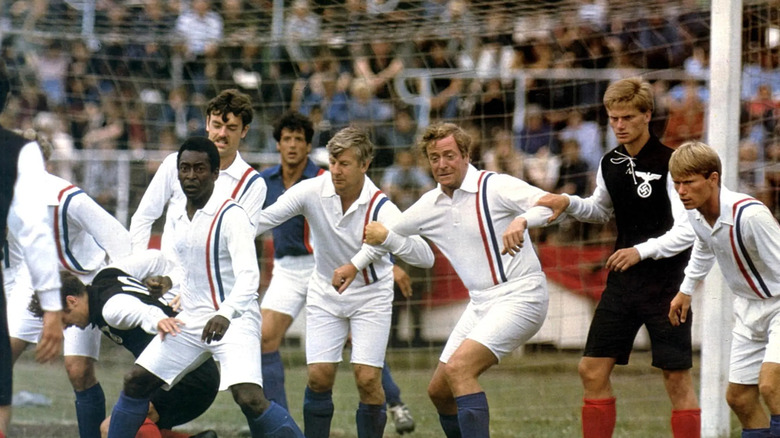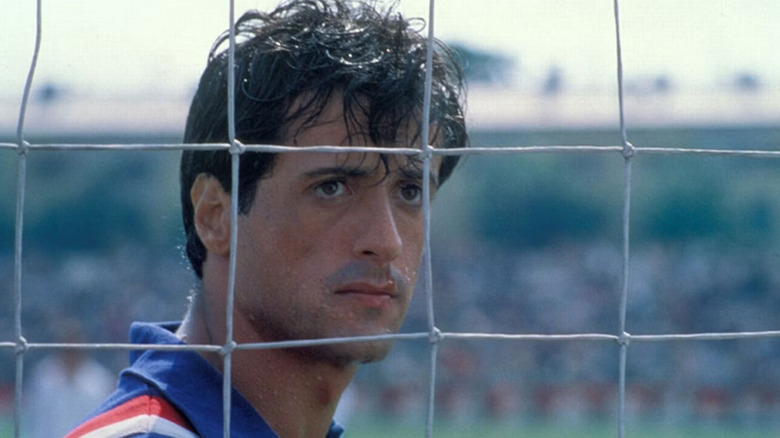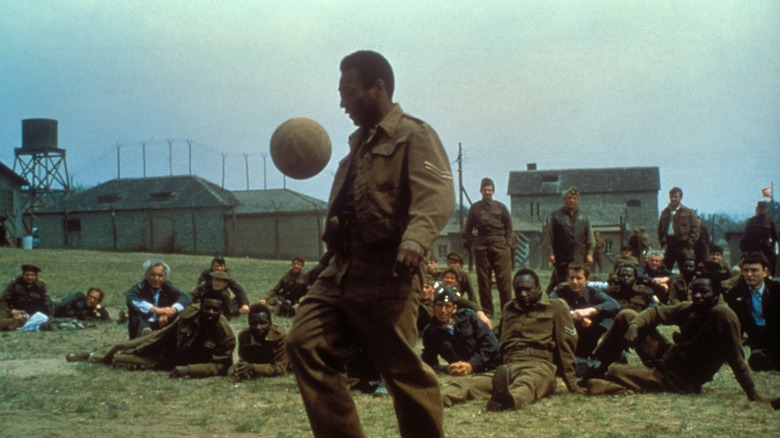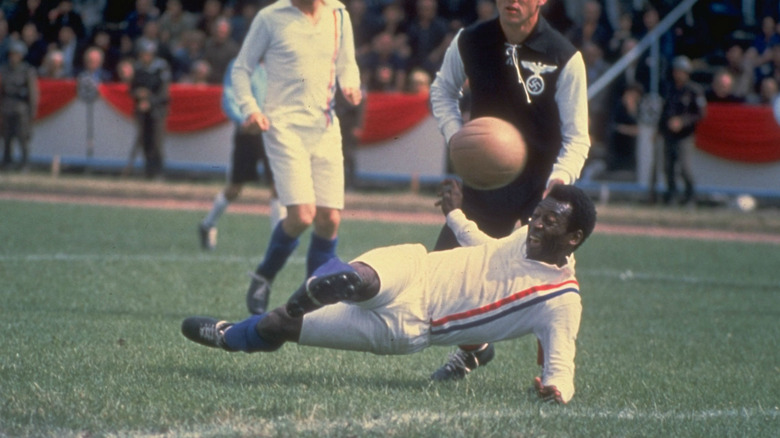Escape To Victory Turned Soccer Star Pelé Into A Cinematic Hero Alongside Sylvester Stallone
Brazilian football legend Pelé passed away at the age of 82 on December 29, 2022. The sad news came less than two weeks after Lionel Messi held aloft the trophy at the Qatar 2022 Word Cup, eliminating any doubt that he deserves his place in the conversation about who is the greatest footballer of all time. Yet for some, the Emir's insistence on honoring the Argentine captain with the traditional bisht was an unwelcome reminder of the controversial venue for the tournament, while his compatriot Diego Maradona's legacy will always be tainted by the "Hand of God." Meanwhile, Pelé remains synonymous with the world's favorite sport at its most exuberant and uninhibited.
Although it's been over 50 years since he last played for the Seleção, Pelé in the brilliant gold and blue of Brazil at the 1970 World Cup, embracing a teammate and punching the air with joy, is one of football's most iconic images. Long before players became brands, Pelé transcended the game to become the most famous footballer in the world, an embodiment of the dazzling skill, grace, and flair that makes the great Brazilian teams so beloved.
Pelé won just about every prize and accolade it was possible for a player to win, including the World Cup in 1958, 1962, and 1970. On top of all that, he even found time to appear in a few movies. Mostly, he played himself in cameos, but his finest cinematic moment came in 1981 when he lined up alongside Sylvester Stallone, Michael Caine, and a host of other soccer stars for John Huston's Boys' Own POW footy adventure, "Escape to Victory."
So what happens in Escape to Victory again?
It's World War II in occupied France and many former professional footballers have put their careers on hold to serve their countries. For the Allies, former West Ham United and England player John Colby (Michael Caine), now held in a POW camp, keeps himself occupied by coaching players in the camp's league system. He's approached by football-loving Major Karl von Steiner (Max von Sydow) with a proposal: How about putting together an Allied team to play an exhibition match against the German national side?
Colby is reluctant but the offer is too tempting to pass up, especially since it means better quarters, rations, and proper football kits for him and the team. He has a few handy players at his disposal; English midfielder Terry Brady (Bobby Moore), tricky playmaker Carlos Rey (Osvaldo Ardiles), and Luis Fernandez (Pelé), who learned to play on the mean streets of Trinidad (Brazil hadn't entered the conflict at the time the film is set). He's less enthused by the rough-and-tumble Robert Hatch (Sylvester Stallone), who wants in on the team to make his escape attempt easier.
The match soon blows up into something massive. Scheduled to play in front of a capacity crowd near Paris, Von Steiner's superiors see it as a propaganda exercise to demonstrate the superiority of the Nazi regime, while Colby's Commanding Officer wants him to use the game as a chance to escape with the whole team.
When kickoff arrives, Colby's team finds themselves battling against a dirty team assisted by a heavily biased referee. They are losing 4-1 by the break, but no matter; the French Resistance have tunneled into their dressing room so they can make their getaway. But who wants to escape when there is a match to win... or draw, as the case may be?
The true story behind Escape to Victory
"Escape to Victory" is based on the Hungarian film "Two Halves in Hell," which, in turn, was inspired by the folkloric "Death Match" that took place in Ukraine during the Second World War. The details are contentious and the story has been altered many times in the intervening 80 years, but it goes something a little like this: When Germany invaded the Soviet Union, pro football was suspended. The owner of a bakery, who employed several players from the country's top club, Dynamo Kyiv, put together an amateur team called FC Start for a tournament against sides from Axis countries, including the occupying Germans.
FC Start finished the tournament without a defeat, their run including a 5-1 win over a German team called Flakelf. A rematch was proposed, which was the most likely basis of the "Death Match" myth. The players were reportedly warned before the game that beating the Germans again would be risky, but the players' superior skill and competitive spirit took over once on the field. According to winger Makar Goncharenko (who played in the game), the Ukrainians went 3-0 down after their goalie was knocked out, only to pull back and win 5-3, to hell with the warnings.
Over the years, the story of the match became embellished, largely thanks to Soviet propaganda. The most dramatic version of the "Death Match" story tells that the players were executed immediately after the game for defying the occupying regime. Some accounts say that FC Start played in other matches in the following weeks, while Goncharenko claimed the team was arrested by the Gestapo. Either way, rumors that several players died or were killed within months of the match added to the game's haunting mythos.
Pelé's great movie moment in Escape to Victory
While Pelé is probably the most recognizable footballer in the cast, "Escape to Victory" is absolutely packed with great players from the era. In terms of screen time, among the most high-profile are West Ham United and England legend Bobby Moore, the World Cup-winning captain who Pelé regarded as the best defender he'd ever played against; tricky Argentinian midfielder Osvaldo "Ossie" Ardiles, a cult hero for North London club Tottenham Hotspur; and, best of all (for me at least) is half the squad from my home club Ipswich Town. We were awesome back then and I used to feel so proud watching the movie as a kid, especially when Russell Osman delivers the key line, "We can win this!"
For almost everyone else, the star of the show is Pelé, who fittingly provides the film's highlight. After the team ditch the escape attempt and return to the field for the second period, they manage to pull the score back to 4-3. Fernandez, who went off with injured ribs after a horrible tackle in the first half, decides he is fit enough to come back on for the last five minutes. With the clock ticking down, he nutmegs an opponent and spreads the play out to Brady on the right, who floats a high cross into the penalty box. Fernandez continues his run and adjusts his body, launching himself into the air to send a majestic overhead kick flying past the desperate reach of the German keeper.
Just to make sure we fully appreciate it, John Huston replays the moment again for us in dreamy slow motion. It's the best bit of the film and, for so many of us who are too young to have seen the great man play, encapsulates everything he stood for in one breathless movie moment.



